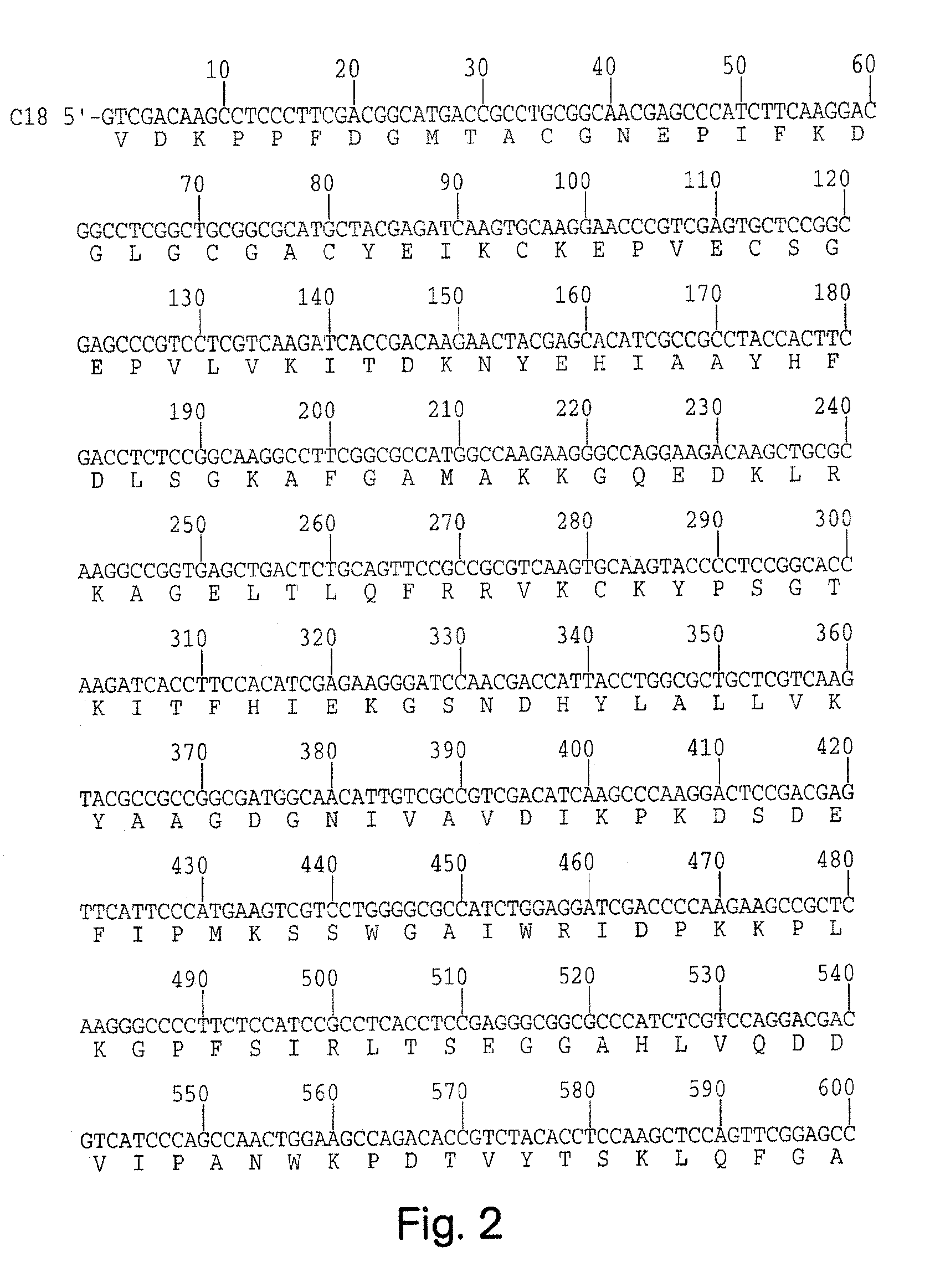Protein allergens of the species cynodon dactylon
a technology of cynodon dactylon and allergens, which is applied in the field of protein allergens of the species cynodon dactylon, can solve the problems of poor quality, polyvalent pollen preparations used as allergens, and limited antibody cross-reactivity of bermuda grass with those of other grasses, so as to diagnose and treat sensitivity in an individual
- Summary
- Abstract
- Description
- Claims
- Application Information
AI Technical Summary
Benefits of technology
Problems solved by technology
Method used
Image
Examples
example 1
Isolation of Cyn d I for Protein Sequencing and MAb Production
Preparation of Pollen Extract
[0063]Bermuda grass pollen was purchased from Greer Laboratories, Lenoir, N.C., USA. To prepare the pollen extract of soluble proteins which was loaded on the Rotofor, 5 grams of Bermuda grass pollen was extracted three times by shaking with 10 ml of 10 mM phosphate buffered saline (PBS) for one hour at 4° C. After each extraction, the mixture was centrifuged (2500 rpm, 10 minutes) and the supernatant collected. After three extractions the supernatants were pooled and filtered through a 3 mm Whatman filter.
Preparative Isoelectric Focusing (IEF)
[0064]Preparative IEF in the Rotofor (Biorad, Richmond, Calif.) has been described in detail by Egan et al. (1988) Analyt. Biochem., 172, 488-494. Briefly, 5 ml of ampholyte solution (Bio-lyte, pH range 3-10; 40%) was added to the pollen extract and the volume adjusted to 50 ml with distilled water. This mixture was loaded into the Rotofor cell and focus...
example 2
Cloning the 5′ End of Cyn d I
[0082]Double-stranded cDNA was synthesized from approximately 4 mg of pollen RNA (Greer Labs, Lenoir, N.C., USA) using the cDNA Synthesis System Plus kit (BRL, Bethesda, Md., USA). After a phenol extraction and ethanol precipitation, the cDNA was blunted with T4 DNA polymerase (Promega, Madison, Wis., USA), and ligated to ethanol precipitated, self-annealed, AT, 5′-GGGTCTAGAGGTACCGTCCGATC-GATCATT-3′, and AL, 5′-p-AATGATCGATGCT-3′ (SEQ ID NO: 29), oligonucleotides for use in a modified Anchored PCR (Marsh et al, 1986: Roux and Dhanarajan, 1990; Rafnar et al, 1991) reaction. cDNA encoding the amino terminus of Cyn d I was amplified from the linkered cDNA (5 ml from a 20 ml reaction) with 1 mg each of oligonucleotides AP, 5′-GGGTCTAGAGGTACCGTCCG-3′ (SEQ ID NO: 30), and CD-5,5′-GATGTGCTCGTAGTTCTT-3′ (SEQ ID NO: 31), an oligonucleotide primer based on non-coding strand sequence of Cyn d I corresponding to the amino acid sequence KNYEHI (SEQ ID NO: 32). The pr...
example 3
[0084]RNA was isolated from the pollen of Cynodon dactylon using a modification of the guanidinium thiocyanate method of Chomczynski and Sacchi (1987) Analytical Biochem. 162: 156-159. Pollen was ground in liquid nitrogen with 9 mls of guanidinium thiocyanate buffer (5M guanidinium thiocyanate in 0.05% Tris-HCl [pH 7.0], 0.05 vol. 13-mercaptoethanol, 0.1 vol. 5% sodium lauroyl sarkosine). The pollen solution was then shaken with phenol (10 ml) for 10 min, after which 10 ml of chloroform:isoamyl alcohol 24:1 was added and the mixture shaken for a further 20 min. The mixture was centrifuged at 7,000×g for 25 min and the aqueous phase collected.
[0085]The aqueous phase was re-extracted with phenol:chlorofomm:isoamyl alcohol 25:24:1 followed by centrifugation at 2,000×g until the interface was clear. The aqueous phase was then decanted into a quickseal ultracentrifuge tube, underlain with a 3 ml CsCl cushion (5.7 M CsCl in 0.1 M EDTA; density=1.71 g / ml) and centrifuged (20 hrs, 40,000 rp...
PUM
| Property | Measurement | Unit |
|---|---|---|
| Fraction | aaaaa | aaaaa |
| Magnetic field | aaaaa | aaaaa |
Abstract
Description
Claims
Application Information
 Login to View More
Login to View More - R&D
- Intellectual Property
- Life Sciences
- Materials
- Tech Scout
- Unparalleled Data Quality
- Higher Quality Content
- 60% Fewer Hallucinations
Browse by: Latest US Patents, China's latest patents, Technical Efficacy Thesaurus, Application Domain, Technology Topic, Popular Technical Reports.
© 2025 PatSnap. All rights reserved.Legal|Privacy policy|Modern Slavery Act Transparency Statement|Sitemap|About US| Contact US: help@patsnap.com



